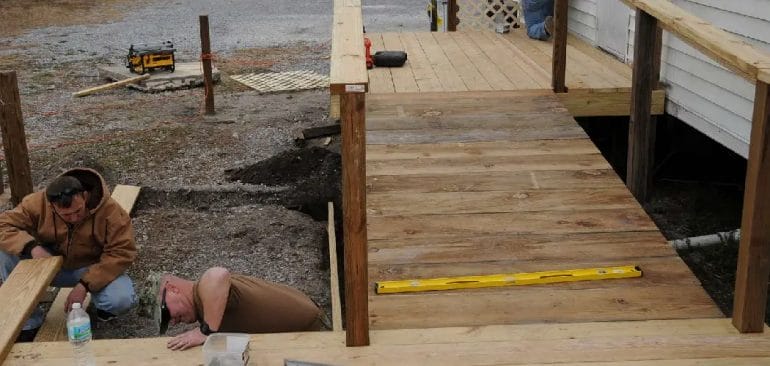Building a wooden ramp over steps can greatly enhance accessibility and convenience for those with mobility challenges. Whether you need to create a ramp for a wheelchair, stroller, or simply to make it easier to navigate steps, a well-designed wooden ramp is a practical solution. With the right tools and materials, you can construct a sturdy and safe ramp that seamlessly blends into the existing steps while adding functionality and style to your space.
When building a wooden ramp over steps, it’s essential to start with careful planning and accurate measurements. Determine the desired slope and length of the ramp to ensure it meets accessibility standards and suits your specific needs. Choose durable materials like pressure-treated lumber to ensure longevity and strength.

Before construction, it’s crucial to check local building codes and obtain any necessary permits. Have a clear understanding of the safety requirements, such as handrails and non-slip surfaces, to ensure your ramp meets all regulations. Additionally, consult with a professional or access a comprehensive guide to ensure proper installation and adherence to building standards.
Once you have gathered all the necessary information and materials, begin the construction process by preparing the steps and the area where the ramp will be installed. Start by removing any obstacles, debris, or loose material that may hinder the installation. Ensure a solid foundation by verifying that the steps are level and securely in place.
Constructing a wooden ramp over steps involves assembling a frame, attaching decking boards, and securing

Planning and Measuring the Dimensions for the Wooden Ramp
When it comes to building a wooden ramp, careful planning and accurate measurements are essential to ensure a safe and functional structure. Whether you are constructing a ramp for a wheelchair, a garden shed, or any other purpose, following the right steps will help you create a ramp that meets your needs and complies with building codes. In this section, we will discuss the important considerations and steps involved in planning and measuring the dimensions for a wooden ramp.
1. Determine the Purpose and Location
The first step in planning a wooden ramp is to determine its purpose and location. Are you building the ramp for wheelchair accessibility, for loading and unloading equipment, or for general use? Knowing the ramp’s intended purpose will help you determine the required width, slope, and other specifications. Additionally, consider the location of the ramp, taking into account factors such as available space, slopes, and any obstacles that need to be addressed.
2. Check Building Codes and Regulations
Before proceeding with your ramp project, it is crucial to check local building codes and regulations. These codes specify the minimum requirements for ramp dimensions, slope, handrails, and other safety features. By adhering to the applicable codes, you ensure that your ramp is safe and meets the legal requirements. Failure to comply with these regulations may result in fines or other legal complications.
3. Calculate the Ramp Length
The next step is to calculate the required length of the ramp. Start by measuring the vertical rise, which is the height from the ground to the top surface where the ramp will connect. This measurement will help determine the ramp’s slope. As a general guideline, the slope should not exceed 1:12, meaning that for every inch of vertical rise, there should be 12 inches of ramp length. For example, if the vertical rise is 12 inches, the ramp should be at least 12 feet long.
4. Determine the Ramp Width
The width of the ramp is another important consideration in ensuring accessibility and safety. The minimum recommended width for a wheelchair ramp is 36 inches, but it is advisable to allow for a wider ramp whenever possible. This additional width provides more space for maneuvering and ensures a comfortable experience for users. Consider the type of equipment or mobility aids that will be used on the ramp to determine the appropriate width.
5. Plan for Landings
Landings are level platforms that serve as transition areas between different sections of the ramp or at points where the ramp changes direction. They are essential for safety and provide resting spots for users. Building codes typically require landings at the top and bottom of the ramp, as well as at any intermediate points where the ramp exceeds a certain length. Plan the dimensions and locations of these landings based on the available space and the needs of users.
6. Consider Handrails and Guardrails
Handrails and guardrails are important safety features that should be included in your ramp design if required by building codes. Handrails provide support and stability for users, while guardrails prevent accidental falls. Check local regulations to determine if handrails and guardrails are necessary and plan their dimensions, height, and spacing accordingly.
7. Gather Materials and Tools
Once you have finalized the dimensions and design of your wooden ramp, it’s time to gather the necessary materials and tools. Depending on the specific design, you may need pressure-treated lumber, screws, nails, concrete footings, and other construction materials. Ensure that you have all the required tools, such as a circular saw, drill, level, and measuring tape, to complete the project efficiently.
8. Measure and Mark the Ramp Layout
With all the necessary materials and tools in hand, it’s time to measure and mark the ramp layout on the ground. Use a measuring tape, level, and chalk or marking spray to outline the dimensions of the ramp, including the length, width, landings, and any other features. Double-check the measurements and ensure that the layout aligns with the planned design.
9. Start Building the Ramp
Now that you have the layout marked, you can begin the construction process. Start by preparing the ground surface and installing any necessary footings. Follow the design plan and secure the lumber pieces together using screws or nails. Pay attention to the accuracy of measurements and the alignment of the ramp components to ensure a sturdy and stable structure.
10. Inspect and Test the Ramp
Once the construction is complete, thoroughly

Step-by-step guide for constructing the wooden ramp over steps
If you have steps leading up to your home or any other structure, you may want to consider building a wooden ramp to provide easier access for individuals with mobility challenges, such as those using wheelchairs or walkers. A wooden ramp can be a practical and cost-effective solution. In this guide, we will walk you through the process of constructing a wooden ramp over steps, step by step.
Materials and Tools Needed
Before you begin the construction process, it’s important to gather all the necessary materials and tools. Here’s a list of what you’ll need:
- Pressure-treated lumber boards
- Plywood sheets
- Concrete footings
- Galvanized nails or screws
- Hammer or drill
- Saw
- Tape measure
- Level
- Pencil
- Safety goggles
1. Measure and Plan
The first step is to measure the height and length of the steps to determine the size of the ramp. Measure from the top of the bottom step to the top of the landing or top step. This will give you the total height of the ramp. Next, measure the total length of the steps to determine the length of the ramp. Take into consideration any additional length needed for the landing at the top or bottom of the ramp.
Using these measurements, create a detailed plan for the ramp. Decide on the width of the ramp, making sure it is wide enough to accommodate the intended users. Consider any regulations or guidelines for ramp construction in your area.
2. Prepare the Site
Clear the area where the ramp will be constructed. Remove any obstacles, debris, or vegetation that may interfere with the construction process. Level the ground to ensure a stable and even surface for the ramp.
3. Install the Footings
Mark the locations for the footings along the planned route of the ramp. Dig holes for the footings, ensuring they are deep enough to reach below the frost line. Place the concrete footings in the holes and allow them to dry and set according to the manufacturer’s instructions.
4. Build the Ramp Frame
Start by building the frame of the ramp using pressure-treated lumber boards. Cut the boards to the required lengths and attach them together using galvanized nails or screws. Ensure the frame is sturdy and level.
5. Install the Decking
Once the frame is complete, install the plywood decking on top. Cut the plywood sheets to fit the dimensions of the ramp and secure them to the frame using nails or screws. Make sure the decking is smooth and level, providing a safe and stable surface.
6. Add Handrails and Safety Features
For added safety, consider adding handrails to the sides of the ramp. Install handrail posts securely into the ramp frame and attach handrails at the desired height. Additionally, add non-slip strips or paint to the ramp surface to improve traction.
7. Inspect and Test
Once the construction is complete, thoroughly inspect the ramp for any potential issues or safety concerns. Test the ramp by wheeling or walking up and down it to ensure it is comfortable and functional.
8. Maintain and Repair
Regularly inspect and maintain the wooden ramp to ensure its longevity and safety. Check for any signs of damage, such as loose boards or protruding nails, and make any necessary repairs promptly.
Summary
Constructing a wooden ramp over steps can greatly improve accessibility for individuals with mobility challenges. By following this step-by-step guide, you can build a sturdy and safe ramp that provides easy access to your home or structure. Remember to plan carefully, gather the necessary materials and tools, and prioritize safety throughout the construction process.

Safety Precautions to Consider While Building a Wooden Ramp
When building a wooden ramp, it is important to prioritize safety in order to create a sturdy and secure structure. Whether you are constructing a ramp for accessibility purposes or for other uses, following safety precautions is crucial. Here are some key considerations to keep in mind:
1. Planning and Design
Before starting the construction of your ramp, it is essential to carefully plan and design the structure. Consider the specific needs and requirements of the ramp users, such as the width, slope, and length of the ramp. Also, ensure that the ramp complies with local building codes and regulations.
2. Choose Quality Materials
When building a wooden ramp, it is important to select high-quality materials that are suitable for outdoor use. Choose pressure-treated or rot-resistant wood to ensure the durability and longevity of the ramp. Additionally, use corrosion-resistant fasteners to secure the wood properly.
3. Proper Foundation
One of the most critical aspects of building a safe wooden ramp is ensuring a solid foundation. The ramp should be securely anchored to the ground to prevent shifting or movement. Use concrete footings or piers to provide a stable base for the ramp.
4. Adequate Width and Slope
The width and slope of the ramp are important factors to consider for both safety and accessibility. The ramp should be wide enough to accommodate wheelchair users comfortably and allow for easy maneuvering. Ensure that the slope meets the recommended guidelines to prevent accidents and make it easy to ascend or descend the ramp.
5. Anti-Slip Surface
To enhance safety and prevent slips and falls, it is crucial to have an anti-slip surface on the wooden ramp. Apply a non-slip treatment, such as a textured paint or adhesive strips, to the ramp surface. This will provide traction, especially during wet or icy conditions.
6. Handrails and Guards
Installing handrails and guards along the sides of the ramp is essential for added safety. Handrails provide support and stability while ascending or descending the ramp, particularly for individuals with mobility challenges. Ensure that the handrails are of suitable height and securely fastened.
7. Adequate Lighting
Good visibility is crucial for safety, especially if the ramp is being used during nighttime or low-light conditions. Install adequate lighting along the ramp to ensure clear visibility of the path. Consider using motion sensor lights to conserve energy.
8. Regular Maintenance
Once the wooden ramp is constructed, regular maintenance is necessary to ensure its continued safety and functionality. Inspect the ramp periodically for any damaged or deteriorated sections and promptly repair them. Regularly clean the surface to remove debris, leaves, or other potential hazards.
In summary, building a wooden ramp requires careful consideration of safety precautions. From planning and design to choosing quality materials and incorporating safety features, each step is crucial to create a secure and accessible ramp. By following these safety guidelines, you can ensure the longevity and safety of your wooden ramp.
Tips for maintaining and preserving the wooden ramp over time
If you have a wooden ramp on your property, whether it’s for wheelchair accessibility or simply for convenience, it’s important to properly maintain and preserve it to ensure its longevity. Wooden ramps can be susceptible to damage from weather, wear and tear, and pests. By following these tips, you can keep your wooden ramp in excellent condition for years to come.
1. Regular cleaning
Regular cleaning is essential to prevent the buildup of dirt, grime, and debris on your wooden ramp. Use a broom or leaf blower to remove leaves, dust, and other loose particles from the surface. For a deeper clean, mix warm water with a mild detergent and scrub the ramp using a soft-bristle brush. Rinse thoroughly with clean water and allow it to dry completely before use.
2. Seal the wood
To protect the wood from moisture and UV damage, it’s crucial to seal the wooden ramp. Choose a high-quality wood sealant or stain that is specifically designed for outdoor use. Apply the sealant according to the manufacturer’s instructions, ensuring even coverage on all surfaces. Regularly check the sealant for signs of wear and reapply as necessary.
3. Repair any damage promptly
Inspect your wooden ramp regularly for any signs of damage, such as cracks, splinters, or loose boards. Promptly repair any issues to prevent further deterioration. Use a wood filler to fill in cracks and gaps, sand down splinters, and replace any loose or damaged boards. Taking care of these small repairs will help maintain the structural integrity of the ramp.
4. Protect against pests
Pests, such as termites and ants, can cause significant damage to wooden ramps. Take preventative measures by applying a pest repellent or insecticide specifically designed for outdoor use. Regularly check for signs of pest infestation, such as holes or sawdust-like debris, and take appropriate action if needed, such as contacting a professional exterminator.
5. Avoid heavy weights
While wooden ramps are designed to support weight, it’s important to avoid placing excessive or concentrated loads on them. Avoid dragging heavy objects across the surface, as this can cause scratches or dents. Additionally, consider using a dolly or ramp to assist with moving heavy items up and down the ramp to minimize the strain on the wood.
6. Clear snow and ice promptly
If you live in an area with snowy or icy conditions, it’s important to clear the ramp promptly to prevent accidents and damage to the wood. Use a snow shovel or snow blower to remove snow from the surface, being careful not to scrape the wood. Sprinkle ice melt or sand on the ramp to provide traction and prevent slipping.
7. Regular inspections
Perform regular inspections of your wooden ramp to identify any potential issues before they become major problems. Check for signs of rot, warping, or loose connections. Address any concerns promptly to ensure the safety and stability of the ramp.
By following these tips, you can extend the lifespan of your wooden ramp and ensure its continued functionality and safety. Regular maintenance and proper care will not only keep your ramp in excellent condition but also provide peace of mind for anyone using it.
FAQs
1. How can I build a wooden ramp over steps?
To build a wooden ramp over steps, measure the height and length of the steps, ensuring the ramp adheres to local building codes. Construct a frame using pressure-treated lumber, add a plywood surface, and install handrails on both sides for safety. Secure the ramp to the steps and make any necessary adjustments for stability.
2. What materials do I need to build a wooden ramp over steps?
You will need pressure-treated lumber for the frame, plywood for the surface, galvanized screws or nails for attaching the components, and handrail materials such as wooden posts and balusters. Additionally, you may need concrete or anchors to secure the ramp to the steps for added stability.
3. Are there any building codes or regulations I need to consider when building a wooden ramp over steps?
Yes, it is important to check your local building codes and regulations before constructing a wooden ramp over steps. Building codes usually specify the maximum slope, width, railing height, and other safety requirements for ramps. You may need to obtain permits or consult with a professional to ensure compliance with these regulations.
Conclusion
In conclusion, building a wooden ramp over steps is a great solution to improve accessibility and safety. By following the steps outlined in this guide, you can confidently create a sturdy and functional ramp that meets your specific requirements.
A well-built ramp not only provides easy access for individuals with mobility challenges, but it also adds value and convenience to your property. With the right materials, tools, and knowledge, you can successfully construct a ramp that blends seamlessly with your existing landscape and architecture.
Remember to carefully plan and measure the area, choose suitable materials that can withstand weather conditions, and ensure proper support and stability. Regular maintenance and periodic inspections will help keep the ramp in excellent condition for years to come.